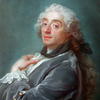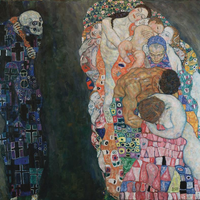More about The Birth of Venus

Contributor
When Francois Boucher painted The Birth of Venus in 1765, France’s Rococo movement was just starting to wind down.
Coming in on the tail end of the Baroque movement— a period characterized by art and architecture that looked like it came straight out of the animated version of "Beauty and the Beast"— the Rococo movement was just as luscious and extravagant, if maybe a smidge less intense. Where Baroque art embraced the drama, Rococo embraced the ornamental. Think lots of pastels, soft, cushy looking shapes, and, you guessed it: lots and lots of naked women. So, when Boucher opted to use pastel colors to paint a soft and cushy looking naked woman, he was pretty darn on the Rococo nose.
Not that this was anything new to Boucher. The dude was a Rococo rock star. He was to Rococo what Tom Cruise is to the action movie. He knew what he was good at and stuck with it, making a name for himself creating giant, elaborate pieces that embraced the amorous and the mythological.
This combination of the sensual and mythical made Venus a natural subject for Boucher. And boy did he take advantage, painting a piece for Louis XIV’s mistress featuring Venus getting ready to hit the town, followed up by a painting of Venus running around in a chariot, Venus shopping for weapons— even another, separate Venus getting born out of clouds painting. The man was, undeniably, a Venus fanboy.
Not like he was the only guy painting Venus— Sandro Botticelli had notably done so almost 300 years prior, and so had a lot of other people— but Boucher's versions of her stand out for a few reasons: his imaginative settings and the delicacy and freedom of his style. This one in particular features loose, almost scribbled brushwork, which is significantly less structured than some of Boucher's previous works. The shapes seem to almost roll off the canvas, and there are sections where it’s hard to tell what is figure and what is foam. So, while this may not be Boucher’s first depiction of Venus, it is certainly his most unique.
Sources
- Britannica, T. Editors of Encyclopaedia. "Anne-Louis Girodet." Encyclopedia Britannica, Invalid Date. https://www.britannica.com/biography/Anne-Louis-Girodet.
- Anonymous. (2020, November 06). Aurora and Cephalus. Retrieved March 31, 2021, from https://www.clevelandart.org/art/2002.101
- Eos (Aurora, Dawn). (n.d.). Retrieved March 31, 2021, from https://www.greek-gods.org/titans/eos.php
- Kimmelman, M. (2006, May 26). Girodet Has His Comeback moment at the Met. Retrieved March 31, 2021, from https://www.nytimes.com/2006/05/26/arts/design/26giro.html
- Kuspit, D. (2006, May 05). Girodet's sensationalism - ARTNET MAGAZINE. Retrieved March 31, 2021, from http://www.artnet.com/magazineus/features/kuspit/kuspit8-16-06.asp












